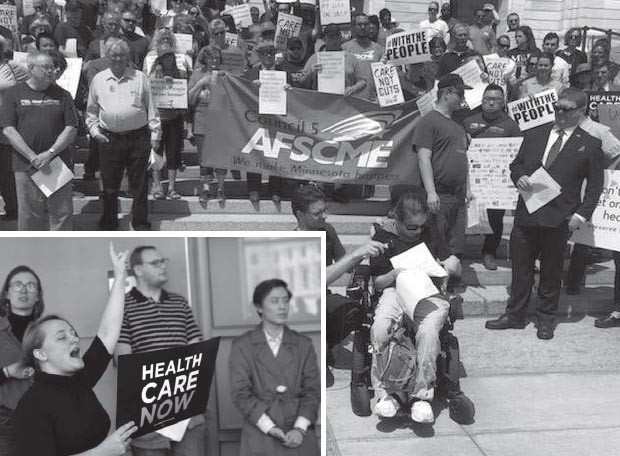2019: Session had victories and defeats
Access Press
6/10/2019 by Jane McClure
For Minnesotans with disabilities, the end of the Minnesota Legislature's 2019 session brought decidedly mixed results. While there is happiness over many gains this year, including additional wages for support staff and preservation of the health care provider tax, there's also the disappointment over measures that didn't pass. The shelved priorities range from improved local government website access to legalizing marijuana plants for medicinal use.
The 2019 Minnesota Legislature met for five months and then held a special session, completing its work the morning of May 25 after a 21-hour marathon. The main event for 2019 was the $48.3 billion two-year budget, which is encompassed by several bills. Health and human services (HHS) spending is the largest share, at about 40 percent.

The "Care Not Cuts" rally included testimony from those who would be most affected by the Minnesota legislature's actions, but the TakeAction "teach-in" drew passionate responses to proposed cuts.
Here’s an overview of disability-related legislation wins and losses. It was very different from 2018, when a contentious fight between state lawmakers and Gov. Mark Dayton resulted in almost everything falling to the veto pen.
Incontinence products
Lawmakers repealed the unpopular Preferred Incontinence Purchasing Program (PIPP). The program, adopted in 2017, was widely criticized for not providing choice and flexibility for consumers. Some feared negative health impacts from inferior personal care products. Legislation has also restricted the Department of Human Services from using its competitive bidding authority on this category of products in the future. Those are big wins for providers involved in the Midwest Association for Medical Equipment Services and Supplies (MAMES).
Insulin
One of the session’s biggest disappointments is the failure to pass an emergency insulin program. Although the effort had bipartisanship support in the House and Senate, it wasn’t enough. Supporters vowed that they’ll be back in 2020.
Familiar issues, big wins
The HHS omnibus bill addresses measures that disability advocate groups have worked on for years, to keep Minnesotans with disabilities and their families from living in poverty. One victory is funding to increase the Medical Assistance spend-down to 100 percent of federal poverty guidelines by July 1, 2022.
Funding was provided to reduce parental fees for MA-TEFRA and HCBS waivers by 15 percent. Money is also earmarked to streamline MA-TEFRA enrollment and renewal. MA-TEFRA has long been criticized for forcing families into poverty, so that they can obtain services for their children. The Minnesota Family Investment Program (MFIP) cash assistance program will also see increases.
Opioids
State lawmakers on the last day of the regular session agreed to create a fund for opioid addiction treatment and prevention. About $20 million is to be raised annually through fees assessed to the drug companies. Prevention strategies to reduce opioid addiction and deaths are a focus, along with helping children and family affected by the opioid crisis.
Transportation
One bright spot is that the state budget will now provide a separate appropriation for Metro Mobility. That will alleviate pressure on the budget for the regular bus and rail system. Metro Mobility also received a one-time funding increase for the next two-year budget cycle to meet increased demand.
Another change is that Metro Mobility will expand its service into Lakeville. Another change allows Metropolitan Council and Minnesota DHS to share data to access federal funds for eligible Metro Mobility rides.
Special education
Increased funding for special education, resulting in $91 million over base in the first biennium (2020-2021), and over $142 million over base in second biennium (2022-2023) is a victory for advocates. There is $90 million to address the cross-subsidy, which is how much school districts have to pay to cover unfunded state and federal mandates. The gap has grown to more than $800 million statewide.

